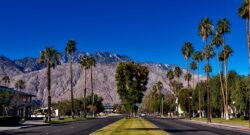Author: dailycastsocal
More Amazing Things To Do In Palm Springs
Explore Sunnylands Center & Gardens: A Jewel in Palm Springs Nestled in the sun-kissed desert landscape of Palm Springs, California, Sunnylands Center & Gardens is a remarkable blend of history, beauty, and culture, making it a must-visit destination for anyone exploring the area. Known for its stunning gardens and as a host to world leaders and dignitaries, this historical estate offers a unique opportunity to experience both the serene desert environment and the legacy of the statesmen who once gathered here. A Glimpse into History Sunnylands, the former estate of philanthropists Walter and Leonore Annenberg, is a legendary venue where U.S. presidents and international leaders have convened over the decades. The estate spans 200 acres and features a mid-century modern mansion designed by architect A. Quincy Jones. Although the mansion itself is not open for public tours, the significance of its past has been preserved through the Center and Gardens, providing visitors with insights into its rich history. High-profile events, including summits and meetings between heads of state, took place here. Sunnylands has become synonymous with diplomacy and leadership, where the issues of the day were discussed amid the tranquil backdrop of the desert. Strolling Through the Gardens The gardens of Sunnylands are an enchanting oasis, beautifully designed to reflect the natural beauty of the region. With over 60 different species of desert plants, the gardens incorporate elements of both California and Mediterranean landscaping, creating a peaceful retreat for visitors. Meandering pathways lead you through lush landscaping, blooming flowers, and serene water features, inviting you to take a leisurely stroll and absorb the tranquility of the outdoor space. Engaging Exhibits The Center offers a variety of exhibits that delve into the estate’s significant past, including photographs, artifacts, and interactive displays that tell the story of Walter and Leonore Annenberg, as well as the wide array of figures who visited Sunnylands for crucial diplomatic discussions. The educational component of the Center enhances the experience, and guided tours are available to provide detailed insights into the gardens, art, and history of the estate. Events and Programs Sunnylands is not just a historical site; it is also a vibrant venue for public events, art exhibitions, and educational programs. The estate hosts a variety of events throughout the year, including yoga classes, lectures, and collaborative workshops that invite community engagement. Make sure to check the Sunnylands website for an up-to-date calendar of events, as attending one can offer a unique way to experience the estate. Planning Your Visit Sunnylands Center & Gardens welcomes visitors with open arms but is committed to maintaining a serene atmosphere. Advance reservations are highly recommended, especially during peak tourist seasons. A small entrance fee may apply, which supports ongoing preservation efforts and initiatives at the estate. When planning your visit, consider arriving in the morning to catch the soft glow of sunrise illuminating the gardens. This magical time provides the perfect backdrop for photography and peaceful reflection. The center also has a small gift shop featuring local art and books that make for memorable keepsakes. Combine Your Visit with Other Palm Springs Attractions While Sunnylands is undoubtedly a highlight, Palm Springs has a wealth of attractions to explore. Consider pairing your visit with a trip to the Palm Springs Art Museum, taking a ride on the Palm Springs Aerial Tramway, or hiking in the nearby Indian Canyons. Each of these experiences offers a unique glimpse into the rich tapestry that makes Palm Springs a beloved destination. Conclusion Sunnylands Center & Gardens stands as a testament to both the beauty of the desert landscape and the pivotal role it has played in shaping diplomatic history. Its combination of tranquil gardens, thought-provoking exhibits, and rich heritage makes it an essential stop on your Palm Springs journey. Whether you’re seeking a quiet moment of reflection or a deeper understanding of this fascinating estate, Sunnylands promises to leave a lasting impression on all who explore its grounds.
3208 Estaban Way, Palm Springs, CA, 92264
3208 Estaban Way Contact ASK Palm Springs for more information. Compass 760-831-7303 Introducing modern perfection in the … source
3 Best Hiking trails in Los Angeles with waterfalls & cave | Free Things to do in LA during Covid
Come see the best unique hiking trails in los angeles with waterfalls, cave and a bridge. Sometimes the best things to do in LA … source
3 MICHELIN STAR | Addison, San Diego
foodiecouple #finedining #michelinrestaurant #luxurydining #michelin #michelinstar #tastingmenu #sandiego #foodies … source
[4K] Downtown Long Beach City, California – Virtual Walking Tour 🎧 Binaural Audio
Walking from Shoreline Village to Pine Avenue in Downtown Long Beach, California. This video contains Binaural Audio. source
Los Angeles Headlines
Diddy reportedly attempted to contact witnesses from prison, according to prosecutors NewsNation Now Source link
San Diego News Update
In 2022, Measure B was approved, enabling the city to implement a trash and recycling collection fee for the first time. SAN DIEGO — Are you aware that San Diego is the sole city in California that does not levy a trash collection fee for most single-family homes? For over a century, the city has offered complimentary trash collection. Then, Measure B was passed in 2022, permitting the city to impose a fee for trash and recycling pickup services. The City of San Diego is currently drafting a proposal for a collection fee by gathering public feedback and performing a cost of service analysis. Over the summer, open houses were organized for residents to learn about the proposed fee and provide their input. At Monday’s community gathering at the Cathy Hopper Friendship Center, insights from previous meetings and an online survey were shared. The findings indicated that residents were most concerned about bulky item pickups, frequent damaged bins, and the disposal of hazardous materials. They expressed significant requests for easier replacement of broken containers and improved recycling options for various items. “All of this data will be compiled into our presentation for the Environment Committee and City Council in early spring of 2025,” stated the Deputy Director of the City’s Environmental Services Department. Additionally, in spring, affected residents will have a 45-day “protest period” to submit further comments via mail. “If the majority of residents support any proposed fees, the matter will then progress to the City Council for final decisions, which could occur in June of 2025,” Deleon remarked. If the fees are approved, residents might start seeing the new charges on their monthly bills in July. The exact amount residents will pay remains uncertain; however, there was a discussion at Monday’s meeting regarding fees charged by nearby cities. Carlsbad, for instance, charges roughly $28 to $31 per month, while Chula Vista’s fees range between $23 and $35. Future open house dates can be found here. An updated online survey is available here. Source link
Palm Springs Headlines
Kate Anderson, director of public relations for the Agua Caliente Band of Cahuilla Indians, speaks to attendees during a recent talk about on the tribe’s award-winning educational curriculum. The Agua Caliente Cultural Museum kicked off its speaker series, “Knowledge: Knowing and Sharing,” earlier this month with a discussion of the development of a contemporary curriculum for Palm Springs Unified School District which educates students about the Tribe’s history and culture. The curriculum is among the first of its kind in California and the greater United States. The speaker series is a program that brings experts, historians, and cultural leaders together to discuss topics related to the history, culture, and contemporary issues of the Agua Caliente Band of Cahuilla Indians. With the series, the tribe hopes to offer insights into their rich heritage and foster a deeper understanding of Indigenous culture and history within the Palm Springs community. In the first lecture of the series, Kate Anderson, director of public relations for the Agua Caliente Band of Cahuilla Indians, hosted a discussion with Tribal Council member John R. Preckwinkle III and former Tribal Council member Anthony Purnel. Both Preckwinkle and Purnel were instrumental in developing the Tribe’s innovative educational curriculum in partnership with the Palm Springs Unified School District. Anderson guided the conversation with questions about the curriculum’s unique approach and its impact on educating local students about the history, culture, and legacy of the Agua Caliente Band of Cahuilla Indians. One of the key takeaways from the lecture is that the Tribe’s curriculum is inspiring Native American tribes nationwide to create similar educational programs. The curriculum, which began implementation in 2018, has reached over 10,000 third-grade students in the past six years and more than 7,000 eighth-grade students in the last four years. “We have more than 5,000 school children visiting the Indian Canyons on field trips every year. Many of those are funded by the tribe who provide school bus grants for the students to take their field trip to the Indian Canyons,” Anderson told attendees. The program, which includes 10 separate lessons for third-graders and a comprehensive unit for eighth-graders, aims to educate students about the tribe’s history, culture, and ongoing presence in the community. Preckwinkle emphasized the importance of hands-on learning in the curriculum. He didn’t want to be the sole creator of the items, so he proposed to the tribal council that they hold classes to teach tribal members how to create the items. This allowed for full involvement from the tribe, rather than just a few people. He wanted the tribe’s descendants and children to be involved in creating the items that students would be handling and learning with. This allowed the tribe to have a direct hand in the materials being used to educate students about their culture. The items, including pinch pots, cloth dolls, yucca fiber sandals, gourd rattles, and more were on display for attendees to touch and interact with. The curriculum’s success has led to its expansion beyond the Palm Springs Unified School District. Purnel noted that other school districts and institutions have shown interest in adopting the program. Agua Caliente Band of Cahuilla Indians Tribal Chairman Reid Milanovich works with Palm Springs Unified School District students in their classroom. (Photo: PSUSD) “We have Desert Sands who are using it as a ninth-grade Native American studies curriculum. Idyllwild Arts Academy has reached out to us and wanted to use our curriculum for their studies up in Idyllwild,” Purnel said. The tribe’s approach to curriculum development has garnered national attention. In 2021, the program received an Honoring Nations Award from the Kennedy School of Government at Harvard University. Purnel and Anderson testified before the California Assembly’s Select Committee on Native American Affairs in March to discuss integrating Native American curriculum within the entire California public school system. The curriculum’s impact extends beyond the classroom. Preckwinkle expressed hope for long-term community benefits as students grow into adulthood with a deeper understanding of the tribe’s culture and presence. “I’m hoping that they will have some kind of respect for us. You know, I’m not asking for a deeper respect, but just an acknowledgment that we exist and that they understand that we still live here,” Preckwinkle said following the event. The tribe’s collaborative approach with the school district and the Foundation for Palm Springs Unified School District has been key to the curriculum’s success. No external consultants were hired, with all content developed jointly by the tribe and school district. This grassroots collaboration model has made the curriculum adaptable and accessible to other educational institutions, including charter and private schools. “When we set out to do this curriculum, the tribe, the foundation and the school district all agreed that this should be a national model, and with any good educational product, it should be shared,” Purnel said. As the program expands, the Agua Caliente tribe remains committed to sharing its educational model with other tribes and school districts interested in developing similar curricula. The tribe’s efforts serve as a blueprint for integrating indigenous history and culture into public education, fostering greater understanding and respect for Native American communities nationwide. “We wanted our membership to know that we are putting ourselves out there for people to learn about us and to know that we are still here; we’re not invisible anymore,” Preckwinkle said. Source link





![[4K] Downtown Long Beach City, California – Virtual Walking Tour 🎧 Binaural Audio [4K] Downtown Long Beach City, California – Virtual Walking Tour 🎧 Binaural Audio](https://wp.fifu.app/socal.dailycast.news/aHR0cHM6Ly9pLnl0aW1nLmNvbS92aS9rYzNFelcxTUEyTS9tYXhyZXNkZWZhdWx0LmpwZw/28a289481954/4k-downtown-long-beach-city-california-virtual-walking-tour-%f0%9f%8e%a7-binaural-audio.webp?w=250&h=135&c=1&p=100000665)


